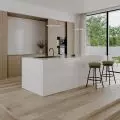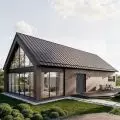"Climate Change Space" is a series of articles on architectural strategies for adapting cities to the climate crisis. Each text will touch on a different issue or function that plazas, parks and streets will have to perform in the near future - from water retention, to providing access to food, to places prepared to welcome climate migrants. Every two weeks, we will look at specific ideas from designers and already implemented solutions for transforming public spaces into a buffer to reduce the negative effects of weather change and provide infrastructure for the crisis.
Partner of the series
Locality
(Episode 3 of the series titled "Climate Change Space")
In Warsaw, it is estimated that transportation is responsible for 60-80% of air pollution production*. In Krakow, depending on the specific type of pollution, the share of cars in smog production is between 13% and 52%. Traffic pollution is one of the main effects of too much functional zoning of the city, concentration of services in shopping malls and turning away from local service points. Emergency situations, such as the current coronavirus threat, show how dangerous it can be to accumulate such functions and, consequently, customers in one place. The arguments are beginning to take on much more weight than mere convenience and economic interest. Shortening the distance a customer has to travel to a retail or service outlet (including public services), dispersing them and covering all areas of the city evenly, counteracting the creation of mono-functional bedrooms and business or commercial districts is becoming important for ecological reasons, economic development of the city, accessibility for the less mobile, but also for safety reasons.
Bottom-up
Changes that support local integration AND its benefits are seen primarily by the local community and activists, which is why projects such as R-URBAN are often born there, which, taking into account the creation of local networks and the undertaking of ecological, economic, social and cultural initiatives, simultaneously with changes on the urban scale, proposes a holistic vision of participatory urban ecology. Under this slogan, activist architects at Atelier d'Architecture Autogéré, which specializes in developing urban tactics and animating space, have hidden a set of concrete actions in the areas of everyday ecology, community habitation, local economics, cultural production, alternative energy sources and urban agriculture. The strategy was developed through a pilot program in Colombes, which allowed the proposed solutions to be tested, including the social participation that is essential at every stage from building the assumptions to implementation and community use. This, in turn, is to ensure the social, environmental and economic sustainability of the results achieved. R-Urban also assumes support and development of already existing or nascent initiatives, rather than just introducing new solutions.
R-Urban
© Atelier d'Architecture Autogérée, CC BY-NC-ND 3.0
R-Urban in Colombes, a suburb of Paris, focused on some of the most relevant issues for the local community. The architects designed AgroCité, an urban growing center consisting of an experimental micro-farm, community gardens, educational and cultural spaces, and facilities for clean energy production, composting and rainwater harvesting. RecyLab, the second component of the strategy, is a facility dedicated to recycling and green, local production. Equipped with all the necessary equipment, the workshop offers the opportunity to repair one's own equipment and upcycle urban waste. The third of the completed facilities, ECoHab, is a complex of experimental housing forms, partly built jointly by the future users, a residential building operating on a cooperative basis.
Looking for a model
When grassroots pressure is sufficient, and the issue that activists and the local community are raising is visible enough, politicians and the media begin to take an interest in the matter. Berlin's ZK/U Center for Art and Urbanism, together with Raumlabor Berlin, AbBa and Berlin's Atelierbeauftragte, is working on the revitalization of the Haus der Statistik, centrally located at Alexanderplatz. The more than 40,000-square-meter building is to be transformed into an affordable housing space, a center for refugees and a workspace for art, culture and education. The areas for meetings, approaches to life and cooperation are intended to create a mutual synergy of integration between the protagonists and the neighborhood. The building is intended to become a prototype representing innovative and inclusive practice, combining culture, education and community engagement under one roof.
Haus der Statistik
© Z/KU, CC BY-NC-ND 4.0
Finally approved and supported by local authorities, the project launched in 2015 grew out of the belief that Berlin's social diversity was under threat. The pressures of continued economic development, rising property values and declining housing affordability have resulted in a deepening exodus of the city's less affluent community of creatives, artists, educators and small entrepreneurs. The proposed project seeks to counter gentrification by offering a quarter in the heart of the city for a socially developed vision of development aimed not at profit but at the common good. As a result of the high-profile efforts of the Haus der Statistik initiative, a group of committed artists, architects, cultural workers and politicians, earlier plans to sell the building to developers and a planned demolition were prevented in 2015.
Haus der Statistik information brochure
[https://hausderstatistik.org/]
Systemically
Sometimes, however, it is the local government that spearheads broad strategies to promote local development throughout the city. The most ambitious plan appears to be the one announced by Paris's ruling Anne Hidalgo, who has made making the French capital a "city of the quarter-hour" one of her main demands in the ongoing local elections in France; along with a range of ideas on mobility, health, housing and ecology, it is the Ville du 1/4h that is expected to win her re-election (In the first round, she received 30% of the vote ahead of the candidate second on the podium by 8 points , source.)
The main idea of the project is to transform the space of Paris in such a way that all necessary functions - a grocery store, a park, a cafe, a school or a workplace - can be reached on foot in 15 minutes, regardless of which part of the city one lives in. The plan, inspired by the work of Jane Jacobs, among others, is intended to make essential functions accessible in every neighborhood (or more narrowly, neighborhood) of Paris, to the point where traditional planning based on commuting to the central district from distant suburbs is being consigned to oblivion.
Le Paris du 1/4 Heure
© Paris En Commun
Implementation of the project has, in a way, already begun. Pedestrian-friendly Paris has increased the number of cyclists by 54% in the last year while dramatically reducing space for cars. The 15-minute city is expected to help combat air pollution that kills 3,000 people annually and save hours spent on private and public transportation. The vision thus focuses not only on how residents get around, but is intended to ensure that functions essential to daily life are evenly distributed so that driving is not necessary at all.
Le Paris du 1/4 Heure
© Paris En Commun
In addition to public services, the plan thus calls for, among other things, the introduction of offices and coworking spaces into parts of Paris dominated by residential and hotel functions. Existing infrastructure such as libraries and stadiums are to be transformed into multifunctional centers. Wherever possible on city-owned plots, Paris authorities also plan to create publicly accessible green spaces - including at school playing fields. Urban forests will be introduced on existing parking lots, a solution that is also expected to reduce the heat island phenomenon. Local community gardens will provide residents with fruits and vegetables, and all access streets to schools - will be closed to cars, increasing children's safety and encouraging commuting by bicycle or scooter.
Localized globalism
What if locality isn't enough, we want to experience diversity, but at the same time reduce the carbon footprint generated by air travel? For this, Icelandic residents will have at their disposal two bio-domes housing an anthropogenic, self-sustaining ecosystem designed to mimic nature. ALDIN Biodome, located in Reykjavik, is scheduled to open in 2021, and its creators argue that it will be a place to celebrate nature in the form of "oases under glass domes."
A visualization of the ALDIN Biodome project,
proj.: WilkinsonEyre, planned completion: 2021
© WilkinsonEyre
Visitors will be able to taste locally produced food in conditions that mimic those of remote corners of the world, diverse ecosystems, health and wellness offerings. The indoor climate will be supported by a year-round geothermal plant, allowing a "sustainable but lush" ecosystem to thrive.



































